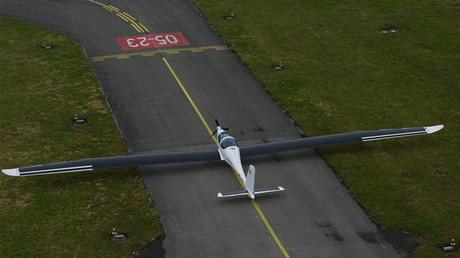Photo of transient atmospheric nanosecond pulse discharges for internal MPC excitation.
iopscience.iop.org
Berkant
Göksel, the lead researcher in a new study by the Technical University
of Berlin, says his team have successfully completed tests on plasma engines that could take future aircrafts to altitudes of 30 miles (50km) and beyond.
The team used a rapid stream of nanosecond-long electric discharges to fire up the propulsion mixture. A similar technique is used in pulse detonation combustion engines, making them more efficient than standard fuel-powered engines.
* Plasma propulsion was proved on an airship in 2005
* this is a pathway to far more powerful and effective plasma propulsion
* this could enable propulsion beyond the height of existing planes
* nearterm it could be for routine airships at 50-100 km
* it could eventually be used to get to orbit and transform aviation and space access
While studies into plasma jet engines has largely focused on their ability to manoeuvre small satellites in the vacuum of space, Göksel told the New Scientist that his research concentrated on testing the engine in a normal atmosphere.
It’s the first time anyone has applied pulse detonation to plasma thrusters. Jason Cassibry at the University of Alabama in Huntsville is impressed. “It could greatly extend the range of any aircraft and lower the operational cost,” he says.
But there are several hurdles to overcome before the technology can propel an actual plane. For a start, the team tested mini thrusters 80 millimetres long, and a commercial airliner would need some 10,000 of them to fly, which makes the current design too complex for aircraft of that size. Göksel’s team plans to target smaller planes and airships for now. Between 100 and 1000 thrusters would be enough for a small plane, which the team thinks is feasible.


A real flight demonstration is the next milestone goal for the project.
The team used 80mm-long mini-thrusters in their experiments – 10,000 of which would be needed to support a commercial airliner. However, Göksel believes the team could test their work on a small plane using between 100 and 1,000 thrusters.

Plans are underway to develop a mobile power generator for use in the first flight demonstration onboard the b-Ionic Airfish. In 2005, the craft became the world’s first airship to be propelled by plasma engines.
It is hoped this experiment helps overcome the project’s major obstacle, which is the huge amount of electricity required to generate and sustain the plasma.

b-Ionic Airfish. iopscience.iop.org
“An array of thrusters would require a small electrical power plant, which would be impossible to mount on an aircraft with today’s technology,” Dan Lev from the Technion-Israel Institute of Technology told the New Scientist.
Göksel is hopeful of working around this with solar panels or potentially beaming power wirelessly to the engines.

A major new breakthrough in jet propulsion technology could
revolutionize the aerospace industry, paving the way for plasma jet
engines that could carry a craft to the edge of space using only air and
electricity.
The challenge was to develop an air-breathing plasma propulsion engine
that could be used for take-off as well as high-altitude flying.
The team used a rapid stream of nanosecond-long electric discharges to fire up the propulsion mixture. A similar technique is used in pulse detonation combustion engines, making them more efficient than standard fuel-powered engines.
* Plasma propulsion was proved on an airship in 2005
* this is a pathway to far more powerful and effective plasma propulsion
* this could enable propulsion beyond the height of existing planes
* nearterm it could be for routine airships at 50-100 km
* it could eventually be used to get to orbit and transform aviation and space access
While studies into plasma jet engines has largely focused on their ability to manoeuvre small satellites in the vacuum of space, Göksel told the New Scientist that his research concentrated on testing the engine in a normal atmosphere.
It’s the first time anyone has applied pulse detonation to plasma thrusters. Jason Cassibry at the University of Alabama in Huntsville is impressed. “It could greatly extend the range of any aircraft and lower the operational cost,” he says.
But there are several hurdles to overcome before the technology can propel an actual plane. For a start, the team tested mini thrusters 80 millimetres long, and a commercial airliner would need some 10,000 of them to fly, which makes the current design too complex for aircraft of that size. Göksel’s team plans to target smaller planes and airships for now. Between 100 and 1000 thrusters would be enough for a small plane, which the team thinks is feasible.


A real flight demonstration is the next milestone goal for the project.
The team used 80mm-long mini-thrusters in their experiments – 10,000 of which would be needed to support a commercial airliner. However, Göksel believes the team could test their work on a small plane using between 100 and 1,000 thrusters.

Plans are underway to develop a mobile power generator for use in the first flight demonstration onboard the b-Ionic Airfish. In 2005, the craft became the world’s first airship to be propelled by plasma engines.
It is hoped this experiment helps overcome the project’s major obstacle, which is the huge amount of electricity required to generate and sustain the plasma.

b-Ionic Airfish. iopscience.iop.org
“An array of thrusters would require a small electrical power plant, which would be impossible to mount on an aircraft with today’s technology,” Dan Lev from the Technion-Israel Institute of Technology told the New Scientist.
Göksel is hopeful of working around this with solar panels or potentially beaming power wirelessly to the engines.



Use synthetic polycrystalline diamond moving repeatedly through an ionizing field to enhance the plasma formation. Somehow it intensifys the energy available
ReplyDelete